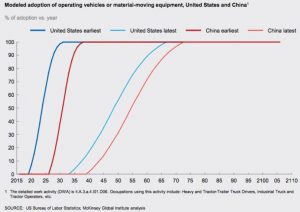
Logistics Trends Impacting Shippers
The Top 6 Trends in Logistics Impacting Shippers in 2018
1. Globalization Will Become More Important in Everyday Decisions.
New markets are emerging in the global economy daily. According to PLS Logistics, global companies will install procurement managers in China for entire organizations by 2025. Meanwhile, Brazil, Russia, and India will become major suppliers as companies access the remaining untapped resources of the world. The need for more raw materials is echoed by Nishith Rastogi of Entrepreneur Media as more products are tossed out in favor of the next best thing.
2. Product Life Cycles Will Grow Shorter and More Complex.
There was a time when buying a computer was considered a once-in-a-decade purchase, if not once-in-a-lifetime. Today, the tech devices that entered the market in early 2016 are obsolescent, and more companies are looking for real-time data-driven decision-making opportunities through the Internet of Things (IoT).
To meet this increased demands, more manufacturing and logistics partners are looking for ways to shorten product lifecycles through improving inventory management systems, changing shipping strategies and altering the fundamental ways products move from point A to point B.
3. Autonomous Trucks Will Drive Logistics Forward.
Autonomous trucks do not require drivers. They are not susceptible to drowsy driving, and they are not subject to electronic logging mandate. They do not require a paycheck, background checks or clearinghouse drug and alcohol testing.
Self-driving trucks might seem like a far-fetched idea, but it became a reality in 2016, and more companies are continuing the push toward this sustainable solution to the driver shortage. Regulations are increasing, and watchdog groups can cause irreparable harm with a simple social media post. However, self-driving trucks have the power to eliminate these problems.
A recent McKinsey Report, explains Gus Lubin of Business Insider, indicates self-driving trucks will take over approximately 100 percent of trucking jobs in the future. This graph shows how quickly the surge begins and rise in 2017.

4. Consumer Demand Will Shape Logistics Services in 2018.
Consumers have power. This has always been true in retail, but the power of consumers has grown with the rise of the digital age. Consumers continue to demand the newest products today, not tomorrow, and the products of the past simply will not cut it for tomorrow’s demand. Consequently, consumer demand will shape logistics providers service offerings throughout the coming year.
Providers will need to focus on predictive analytics to get ahead of tomorrow’s needs by adjusting operations to reflect today’s immediate demand. Meanwhile, the use of Big Data will empower new fleets and freight optimization and consolidation measures, and the IoT will provide new insights. As explained by Zvi Schreiber, CEO of Freightos, saving time for end users will be the cornerstone of all logistics operations in 2017.
5. Organizations Will Streamline Reverse Logistics.
Getting products to business-to-business partners and consumers is only half the battle. These products may have another life when their raw materials are recycled and repurposed. The products may be returned for defects or because of buyer’s remorse. Ultimately, the flow of products must be seamlessly bidirectional.
If a company does not have standard reverse logistics processes in place, repeat purchases could be lost. Amazon understands the value of an easy-to-use reverse logistics strategy.
For example, a consumer can access the Amazon Returns Center and initiate the shipping label printing and shipping of products from any internet-accessible device. But, Amazon’s service after the sale does not end there.
Consumers can try to sell an unwanted product as a seller once the return window closes, so the reverse logistics process becomes full circle with new-product logistics and shipping. This model of bidirectional operation will further encourage supply chain logistics providers to streamline reverse logistics throughout 2017.
6. The Amazon Barbell Will Gain Power.
Amazon’s unsurpassed capability in logistics has stimulated a barbell effect among manufacturers and retailers. Essentially, you can have strong high-end products or hyper-local convenience for consumers. But, you cannot exist in between the two strong ends. In other words, the diversity of Amazon has made it difficult for companies to continue providing one-size-fits-all products to consumers. However, this action can be mitigated successfully, reports Karl Seibrecht of Flex Blog, through “in-store pickup, ship-to-store initiatives, and pop-us distribution solutions.”
Like 2016, logistics providers will be tested for weaknesses in 2017. For organizations that do not embrace these trends in logistics, the road will quickly divert to Chapter 11 bankruptcy. Additionally, improving operations in response to the top six trends in logistics could stimulate growth and prosperity among providers. However, logistics providers must also consider the remaining six other factors in part two of this series.
Leave a Reply